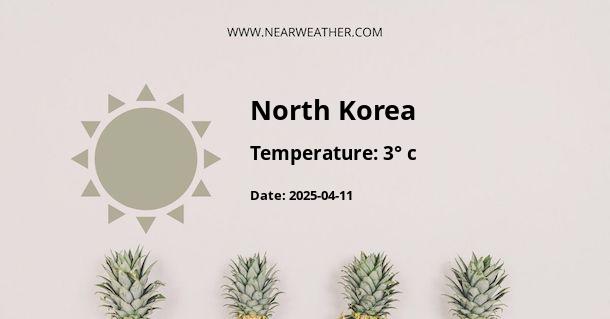Climate and Weather in the Democratic People's Republic of Korea (KP)
The Democratic People's Republic of Korea (KP), commonly known as North Korea, is located on the northern part of the Korean Peninsula in East Asia. The country experiences a diverse climate due to its varied topography and geographical location. Understanding the climate and weather patterns in KP is essential for travelers and those interested in the country's meteorological conditions.
Geographical Factors
KP's climate is influenced by several geographical factors. The country shares its borders with China and Russia to the north, and it is surrounded by sea on the east, west, and south. The mountainous terrain in the northern and eastern regions, including the Hamgyong Mountains, has a significant impact on the weather patterns within the country.
Four Distinct Seasons
KP experiences four distinct seasons: spring, summer, autumn, and winter. Each season brings its own unique weather conditions and temperature variations.
Spring (March to May)
Spring in KP is characterized by a gradual transition from cold to mild weather. March is still chilly, with temperatures ranging from 2°C to 9°C (36°F to 48°F). As the season progresses, temperatures rise, and by May, they typically range from 12°C to 20°C (54°F to 68°F). Spring also sees an increase in rainfall, with April being the wettest month. The blossoming cherry trees and colorful flowers make this season particularly beautiful.
Summer (June to August)
Summer in KP is hot and humid, with average temperatures ranging from 20°C to 30°C (68°F to 86°F). July and August are the warmest months, with temperatures occasionally exceeding 35°C (95°F). The southern parts of the country experience higher temperatures compared to the northern mountainous regions. Summer also brings the monsoon season, with heavy rainfall and occasional thunderstorms.
Autumn (September to November)
Autumn in KP is considered the most pleasant and picturesque season. The temperatures gradually decrease from the summer heat, ranging from 15°C to 25°C (59°F to 77°F) in September, to 5°C to 15°C (41°F to 59°F) in November. The autumn foliage creates stunning landscapes, particularly in the mountainous regions. September and October are relatively dry months, making it an ideal time to visit and explore the country.
Winter (December to February)
Winter in KP is cold and dry, with temperatures dropping below freezing. The northern regions experience more severe winters compared to the southern parts. Average temperatures range from -10°C to 0°C (14°F to 32°F), with January being the coldest month. Snowfall is common, especially in the mountainous areas. It is advisable to pack warm clothing if visiting during this season.
Regional Variations
Due to its diverse topography, KP exhibits regional variations in climate and weather patterns.
Pyongyang: The capital city of Pyongyang experiences similar weather conditions to the central region of the country, with slightly milder winters and warmer summers compared to the mountainous areas.
Hamhung: Located on the eastern coast, Hamhung experiences more rainfall compared to other regions. Summers can be hot and humid, while winters are cold and snowy.
Mount Kumgang: This mountainous region in the southeast experiences cooler temperatures throughout the year, with colder winters and milder summers compared to the rest of the country. The area is known for its natural beauty and attracts many tourists.
Climate Data for Major Cities
Here is a table presenting average temperature and precipitation data for three major cities in KP:
| City | Spring | Summer | Autumn | Winter |
|---|---|---|---|---|
| Pyongyang | 9°C - 20°C (48°F - 68°F) |
20°C - 30°C (68°F - 86°F) |
15°C - 25°C (59°F - 77°F) |
-10°C - 0°C (14°F - 32°F) |
| Hamhung | 8°C - 18°C (46°F - 64°F) |
21°C - 29°C (70°F - 84°F) |
14°C - 23°C (57°F - 73°F) |
-7°C - 1°C (19°F - 34°F) |
| Mount Kumgang | 5°C - 15°C (41°F - 59°F) |
15°C - 25°C (59°F - 77°F) |
10°C - 20°C (50°F - 68°F) |
-5°C - 5°C (23°F - 41°F) |
Note: The temperature ranges provided are approximate and can vary from year to year.
Clothing Recommendations
When visiting KP, it is important to pack appropriate clothing based on the season and region. Here are some general recommendations:
- Spring: Layered clothing, light jacket, and an umbrella for possible showers.
- Summer: Lightweight and breathable clothing, sunscreen, and a raincoat or umbrella for monsoon season.
- Autumn: Light to medium-weight clothing, a light jacket or sweater for cooler evenings, and comfortable walking shoes.
- Winter: Heavy winter clothing including a warm coat, hat, gloves, scarf, and sturdy boots.
Conclusion
The Democratic People's Republic of Korea experiences a diverse climate with four distinct seasons. From the beautiful cherry blossoms in spring to the colorful autumn foliage, each season brings its own charm. Travelers should be prepared for varying weather conditions based on the time of year and region they plan to visit. By understanding the climate and weather patterns, visitors can make informed decisions about their travel plans and pack accordingly.
A - North Korea's Latitude is 40.000000 & Longitude is 127.000000.
A - Weather in North Korea is 3° today.
A - Climate Conditions in North Korea shows few clouds today.
A - Humidity in North Korea is 68% today.
A - Wind speed in North Korea is 6.12 km/h, flowing at 290° wind direction. today.
